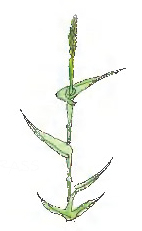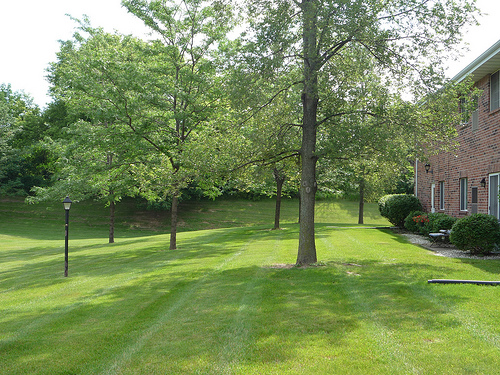
Imagine a house without a lawn, a golf course without smooth greens, a football game without a groomed field. Indeed, they’re all hard to picture. Lawns and turf are so much a part of our lives that we cannot imagine a different scene. Yet the lawn as we now know it—emerald green grass, uniform blades, weed-free—is a relatively recent obsession.
Earlier in America the area outside a front door might have had packed dirt or a mix of flowers, herbs, and vegetables. Our native grasses were unsuitable for a tidy lawn, and sporadic rainfall is often insufficient to keep grass green all summer. Two of our early presidents, Washington and Jefferson, resorted to sheep to keep their lawns short. People with servants used scythes to trim the lawn.
Not until the industrial revolution did lawns become practical for most Americans. The development of the garden hose by B.F. Goodrich and the reel motor in the late 1800s made lawn care possible for the middle class. Later, in 1938, laws stipulating a 40-hour work week gave Americans a weekend and so more leisure time to devote to yard work.
With the burst of suburban living after WWII, houses had more space around them. Also herbicides, pesticides, and fertilizers became readily available. Life style magazines and the lawn care industry promoted the brilliant green sward. A beautiful lawn became associated with good citizenship and neighborliness.
Now lawns and turfgrass are a multimillion dollar business—about $60 to 75 billion in the U. S. each year. Turfgrass is the third largest crop in total acreage nationwide. In Minnesota, the turfgrass industry (sod farmers, lawn care workers, seed companies, retail and wholesalers, golf course greens managers, etc.), contributes $8 billion dollar yearly to the state’s economy. The University of Minnesota and many other universities offer degrees in turfgrass management.
Size of the Industry (Estimates)
| Acres of home lawn in U.S. | 25,000,000 acres (a little less than half the size of Minnesota) |
| Acres of turfgrass in U.S. | 50,000,000 acres / 500,000 in Minnesota |
| # of employees in the industry | 1,600,000 employees / 54,000 in Minnesota |
| Monetary value in U.S. | $60-75 billion dollars / $10 billion in Minnesota |
| # of lawnmowers in the U.S. | 38,000,000 |
| # of golf courses in the U.S. | 15,753 / 470 in Minnesota |
Lawns can have a positive environmental impact. With proper management, a lawn has many benefits. A healthy lawn protects soil from water and wind erosion. Turf absorbs heat, reducing the need for air conditioners. Runoff from hard surfaces such as parking lots and roads contains many contaminants. Turfgrass purifies the water as it leaches through the root zone and into the underground aquifers. The millions of grass plants in lawns, golf courses, roadsides help clean the air, trap dust and remove carbon dioxide and other greenhouse gases from the atmosphere.
Lawns and the Environment
A number of environmental experts have stated concerns over this American obsession. High maintenance lawns, especially those in more arid locations can require 54% more water than mixed landscaping (water-conserving trees, shrubs and plants). Gas powered lawn equipment contributes heavily to air pollution. A typical (4hp) mower when operated for one hour produces as much smog-forming hydrocarbons as an average car does in 100 miles. The run-off of nutrients, from fertilizers and herbicides may be considerable. For example, phosphorus became such a large issue that the Minnesota legislature passed the Minnesota Phosphorus Lawn Fertilizer Law to benefit lakes and rivers. Mowers and other lawn equipment contribute to noise pollution.
Many of these problems can be minimized with careful and thoughtful environmental practices. The EPA (Environmental Protection Agency) passed new rules requiring gas-powered engines in lawn and garden equipment to cut smog-forming emissions by 35 percent by 2011. Once fully implemented, the EPA estimates that annual emission reductions of hydrocarbons, nitrogen oxide, and carbon monoxide will be significant.
Homeowners should have a soil test before applying fertilizers to see what the lawn actually needs. Routine application of chemicals should be questioned annually. Lawn clippings provide several benefits and should always be left on the lawn, and not on impervious surfaces. Clippings add nitrogen for lawns and can reduce the need for added fertilizer. They also shade the soil surface and reduce moisture loss due to evaporation.
To help conserve water, homeowners should water infrequently but thoroughly. They should avoid frequent watering that promotes shallow roots and weeds, and water early in the day if possible to avoid evaporation.

Lawn and turf grass make up a significant portion of the land we use in the United States, about 25 million acres. The overuse of fertilizers on these grasses can be a serious environmental issue because this excess fertilizer can easily runoff of the soil or through the soil into water supplies which are used by humans. Once in the water, the excess nutrients cause eutrophication which causes excess algae growth and hypoxia which is a lack of oxygen in the water. The lack of oxygen kills populations of animals using the water body. The use of phosphorus fertilizer on established lawns has been banned by the state of Minnesota and this same issue has been taken up by many other states where similar legislation has been passed. Runoff of nutrients can also be cause by organic matter, grass clippings for example, being left in the street. As a class, we agreed that it is necessary to educate the public on the chemicals they’re using, what they do to ones lawn, and what they can do to help prevent runoff and preserve our waterbodies as opposed to having more laws and restrictions. We also believe that it is a good idea for the public to be planting a larger variety of plants in their yards to reduce the area where fertilizers are needed. A vegetable garden could be a good use of this space, providing not only a hobby for the home owner, but also food for the family.
Manage Your Lawn To Have a Positive Environmental Impact
- Manage irrigation practices in order to prevent over watering. Mandatory rain sensors (automatically shuts off sprinkler system when it rains) are a good solution to preserve water. Do not allow water to runoff into streets.
- Start with a soil test. Every 3-4 years, have your soil tested before applying fertilizer to see what your soil actually needs. This could save time and money.
- Learn What Grass You Have. Different types of grass require more inputs, elite Kentucky bluegrass takes a lot of water and fertilizer, but fine fescue is just the opposite.
- Fall Fertilization. Newest recommendations call for early, but not necessarily late fall fertilization. Late fertilization is more subject to runoff and nutrient loss.
- Never remove lawn clippings. Lawn clippings benefit the lawn with plant nutrients and shade the surface, thereby reducing moisture loss.
- Know your mowing height. In the summer you can improve your lawn’s stress tolerance by increasing the mowing height half an inch. For most lawn areas, mowing at a height of 2.5 – 3.0 inches will provide a good quality turf.
- Use a Push Mower. If you have a city lot or small yard, try a push mower. The new ones are easy to use, quiet, and remain sharp for 5- 10 years!
- Spot Treat Weeds. Annual applications of broadcast weed control may not be necessary if you are managing healthy turf. Spot treating weeds will allow you to keep nitrogen adding clover and other legumes that provide pollen and nectar for bees.
- For more information on proper lawn maintenance, visit University of Minnesota Extension Lawn Care.
Did You Know?
- Over 25 million acres of lawn are tended in the U.S.
- One single grass plant can have 387 miles of roots.
- In a thick, healthy lawn there are 6 turf grass plants in each square inch, 850 turf plants in a square foot, and about 7 million turf plants in an average lawn of 8,000 square feet.
- U.S. turf traps an estimated 12 million tons of dust and dirt annually.
- A 50’ by 80’ lawn releases enough oxygen for a family of four.
- With sufficient water and light, grass grows 2.5” in one week.
- Of the estimated 7,500 grass species, 50 are cultivated for turf.
- For the World Cup soccer in 1994, the Pontiac Silverdome grew its turf off-site, transported it to the dome in containers, and then reassembled it for the elite soccer matches.
For more information see the 10 Plants That Changed Minnesota MSHS book.